2009 BMW Z4 SDRIVE30I ROADSTER wheel size
[x] Cancel search: wheel sizePage 86 of 248
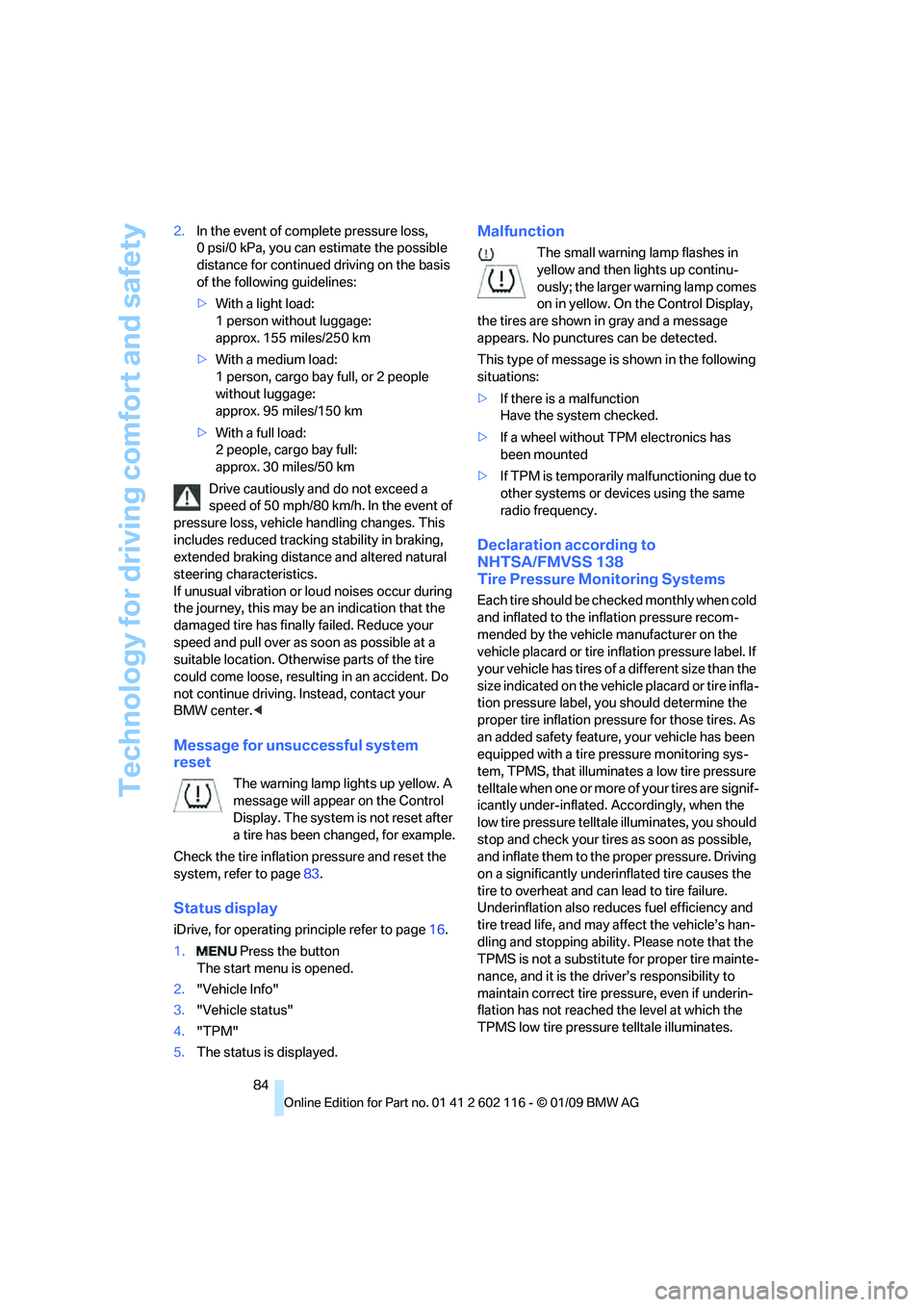
Technology for driving comfort and safety
84
2.
In the event of complete pressure loss,
0 psi/0 kPa, you can estimate the possible
distance for continued driving on the basis
of the following guidelines:
>With a light load:
1 person without luggage:
approx. 155 miles/250 km
> With a medium load:
1 person, cargo bay full, or 2 people
without luggage:
approx. 95 miles/150 km
> With a full load:
2 people, cargo bay full:
approx. 30 miles/50 km
Drive cautiously and do not exceed a
speed of 50 mph/80 km/h. In the event of
pressure loss, vehicle handling changes. This
includes reduced tracking stability in braking,
extended braking distance and altered natural
steering characteristics.
If unusual vibration or lo ud noises occur during
the journey, this may be an indication that the
damaged tire has finally failed. Reduce your
speed and pull over as soon as possible at a
suitable location. Otherw ise parts of the tire
could come loose, resulting in an accident. Do
not continue driving. Instead, contact your
BMW center. <
Message for unsuccessful system
reset
The warning lamp lights up yellow. A
message will appear on the Control
Display. The system is not reset after
a tire has been changed, for example.
Check the tire inflation pressure and reset the
system, refer to page 83.
Status display
iDrive, for operating pr inciple refer to page16.
1. Press the button
The start menu is opened.
2. "Vehicle Info"
3. "Vehicle status"
4. "TPM"
5. The status is displayed.
Malfunction
The small warning lamp flashes in
yellow and then lights up continu-
ously; the larger warning lamp comes
on in yellow. On the Control Display,
the tires are shown in gray and a message
appears. No punctures can be detected.
This type of message is shown in the following
situations:
> If there is a malfunction
Have the system checked.
> If a wheel without TPM electronics has
been mounted
> If TPM is temporarily malfunctioning due to
other systems or devices using the same
radio frequency.
Declaration according to
NHTSA/FMVSS 138
Tire Pressure Monitoring Systems
Each tire should be checked monthly when cold
and inflated to the inflation pressure recom-
mended by the vehicle manufacturer on the
vehicle placard or tire infl ation pressure label. If
your vehicle has tires of a different size than the
size indicated on the vehicle placard or tire infla-
tion pressure label, yo u should determine the
proper tire inflation pressure for those tires. As
an added safety feature, your vehicle has been
equipped with a tire pressure monitoring sys-
tem, TPMS, that illuminates a low tire pressure
telltale when one or more of your tires are signif-
icantly under-inflated. Accordingly, when the
low tire pressure telltale illuminates, you should
stop and check your tires as soon as possible,
and inflate them to the proper pressure. Driving
on a significantly underi nflated tire causes the
tire to overheat and ca n lead to tire failure.
Underinflation also reduces fuel efficiency and
tire tread life, and may affect the vehicle’s han-
dling and stopping ability. Please note that the
TPMS is not a substitute for proper tire mainte-
nance, and it is the dr iver’s responsibility to
maintain correct tire pressure, even if underin-
flation has not reached the level at which the
TPMS low tire pressure telltale illuminates.
Page 192 of 248
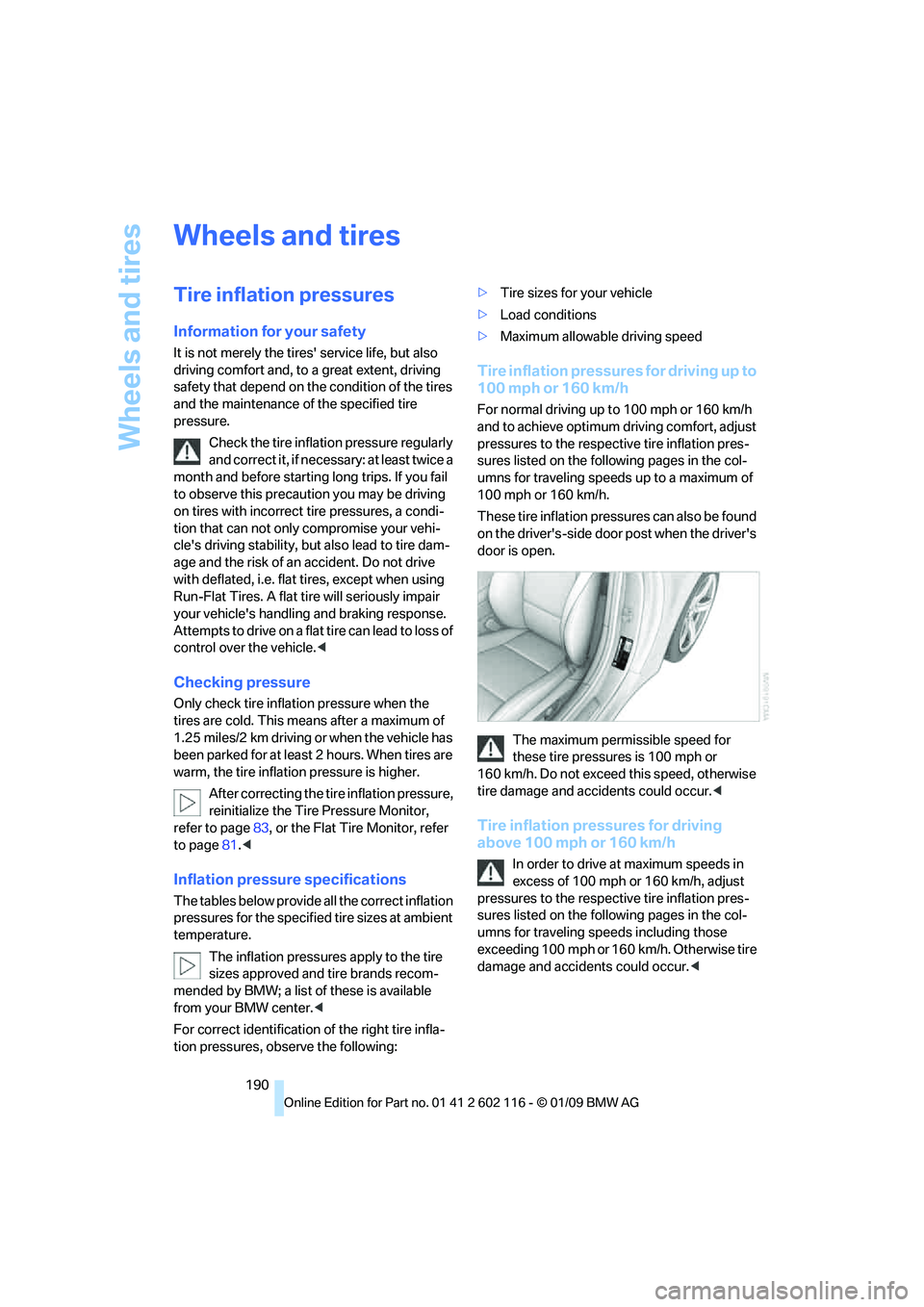
Wheels and tires
190
Wheels and tires
Tire inflation pressures
Information for your safety
It is not merely the tires' service life, but also
driving comfort and, to a great extent, driving
safety that depend on the condition of the tires
and the maintenance of the specified tire
pressure.
Check the tire inflatio n pressure regularly
and correct it, if necessary: at least twice a
month and before starting long trips. If you fail
to observe this precaution you may be driving
on tires with incorrect tire pressures, a condi-
tion that can not only compromise your vehi-
cle's driving stability, but also lead to tire dam-
age and the risk of an accident. Do not drive
with deflated, i.e. flat tires, except when using
Run-Flat Tires. A flat tire will seriously impair
your vehicle's handling and braking response.
Attempts to drive on a flat tire can lead to loss of
control over the vehicle.<
Checking pressure
Only check tire inflation pressure when the
tires are cold. This means after a maximum of
1.25 miles/2 km driving or when the vehicle has
been parked for at least 2 hours. When tires are
warm, the tire inflatio n pressure is higher.
After correcting the tire inflation pressure,
reinitialize the Tire Pressure Monitor,
refer to page 83, or the Flat Tire Monitor, refer
to page 81.<
Inflation pressure specifications
The tables below provide all the correct inflation
pressures for the specified tire sizes at ambient
temperature.
The inflation pressures apply to the tire
sizes approved and tire brands recom-
mended by BMW; a list of these is available
from your BMW center. <
For correct identification of the right tire infla-
tion pressures, observe the following: >
Tire sizes for your vehicle
> Load conditions
> Maximum allowable driving speed
Tire inflation pressures for driving up to
100 mph or 160 km/h
For normal driving up to 100 mph or 160 km/h
and to achieve optimum driving comfort, adjust
pressures to the respecti ve tire inflation pres-
sures listed on the follo wing pages in the col-
umns for traveling speeds up to a maximum of
100 mph or 160 km/h.
These tire inflation pre ssures can also be found
on the driver's-side door post when the driver's
door is open.
The maximum permissible speed for
these tire pressures is 100 mph or
160 km/h. Do not exceed this speed, otherwise
tire damage and accidents could occur. <
Tire inflation pressures for driving
above 100 mph or 160 km/h
In order to drive at maximum speeds in
excess of 100 mph or 160 km/h, adjust
pressures to the respecti ve tire inflation pres-
sures listed on the follo wing pages in the col-
umns for traveling speeds including those
exceeding 100 mph or 160 km/h. Otherwise tire
damage and accidents could occur. <
Page 194 of 248
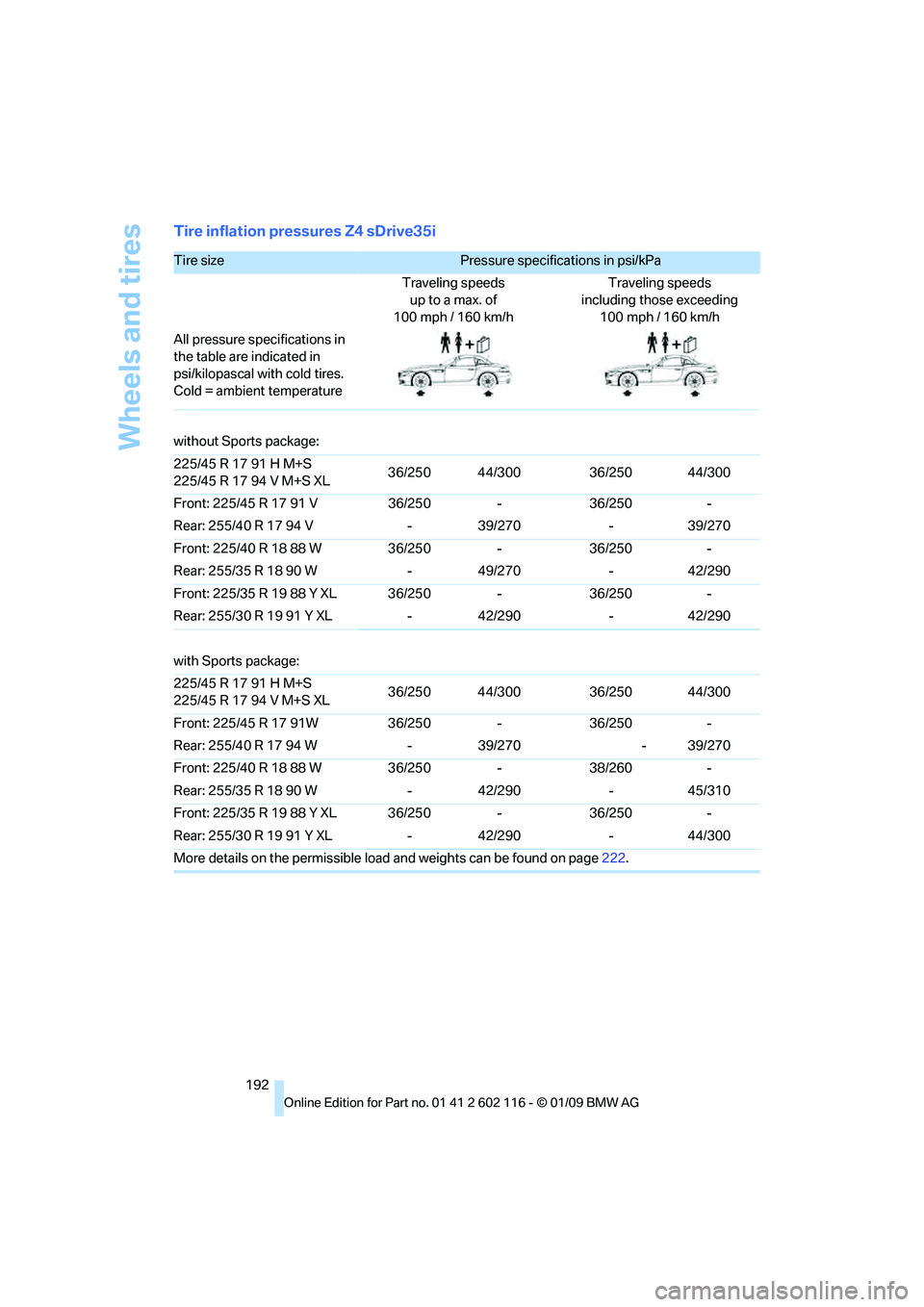
Wheels and tires
192
Tire inflation pressures Z4 sDrive35i
Tire size Pressure specifications in psi/kPa
Traveling speeds up to a max. of
100 mph / 160 km/h Traveling speeds
including those exceeding 100 mph / 160 km/h
All pressure specifications in
the table are indicated in
psi/kilopascal with cold tires.
Cold = ambient temperature
without Sports package:
225/45 R 17 91 H M+S
225/45 R 17 94 V M+S XL 36/250 44/300
36/250 44/300
Front: 225/45 R 17 91 V 36/250 -36/250-
Rear: 255/40 R 17 94 V - 39/270-39/270
Front: 225/40 R 18 88 W 36/250 -36/250-
Rear: 255/35 R 18 90 W - 49/270-42/290
Front: 225/35 R 19 88 Y XL 36/250 - 36/250-
Rear: 255/30 R 19 91 Y XL - 42/290-42/290
with Sports package:
225/45 R 17 91 H M+S
225/45 R 17 94 V M+S XL 36/250 44/300
36/250 44/300
Front: 225/45 R 17 91W 36/250 -36/250-
Rear: 255/40 R 17 94 W - 39/270 - 39/270
Front: 225/40 R 18 88 W 36/250 -38/260-
Rear: 255/35 R 18 90 W - 42/290-45/310
Front: 225/35 R 19 88 Y XL 36/250 - 36/250-
Rear: 255/30 R 19 91 Y XL - 42/290-44/300
More details on the permissible load and weights can be found on page222.
Page 197 of 248
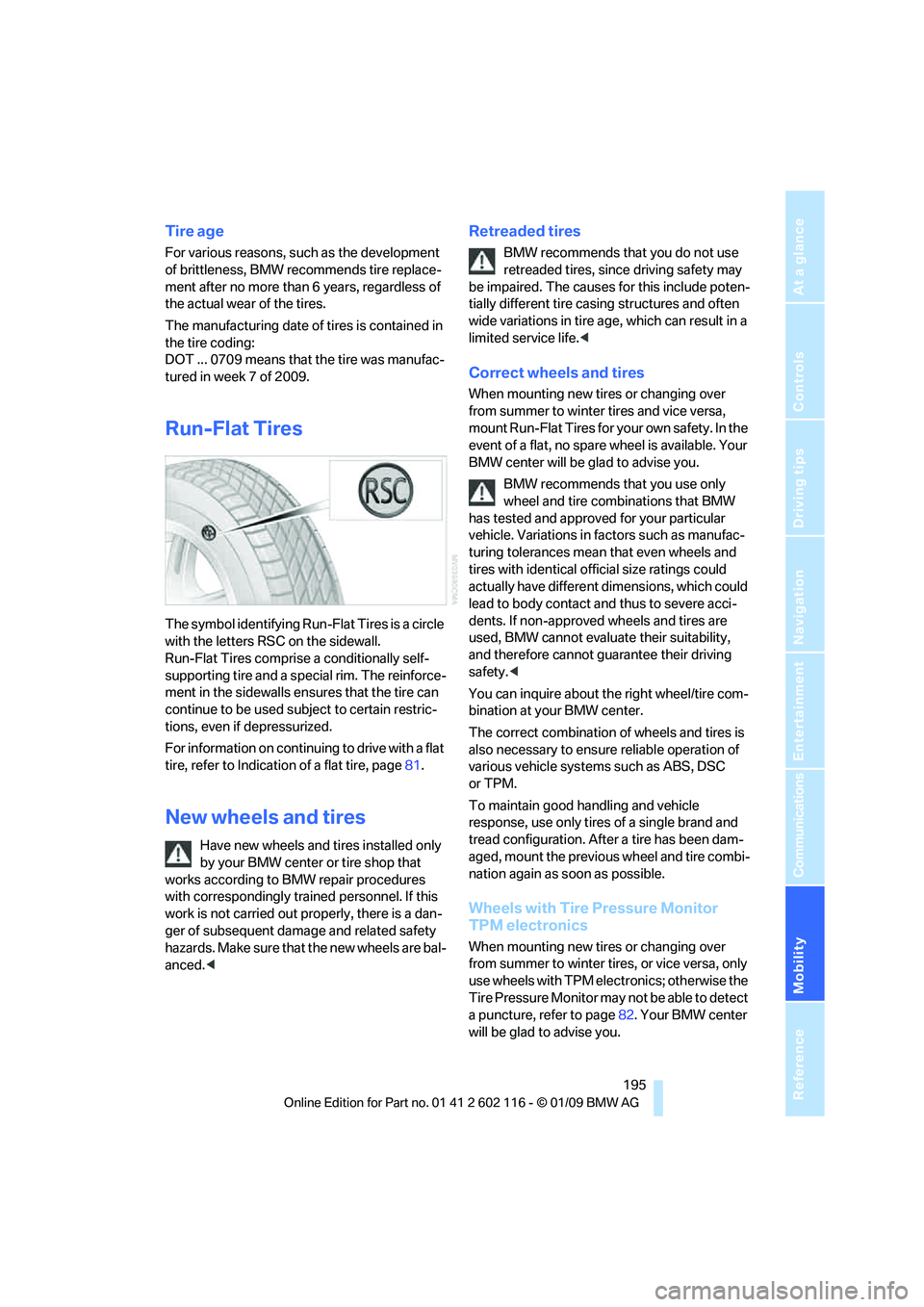
Mobility
195Reference
At a glance
Controls
Driving tips
Communications
Navigation
Entertainment
Tire age
For various reasons, such as the development
of brittleness, BMW recommends tire replace-
ment after no more than 6 years, regardless of
the actual wear of the tires.
The manufacturing date of tires is contained in
the tire coding:
DOT ... 0709 means that the tire was manufac-
tured in week 7 of 2009.
Run-Flat Tires
The symbol identifying Run-Flat Tires is a circle
with the letters RSC on the sidewall.
Run-Flat Tires comprise a conditionally self-
supporting tire and a special rim. The reinforce-
ment in the sidewalls ensures that the tire can
continue to be used su bject to certain restric-
tions, even if depressurized.
For information on continuing to drive with a flat
tire, refer to Indication of a flat tire, page 81.
New wheels and tires
Have new wheels and tires installed only
by your BMW center or tire shop that
works according to BMW repair procedures
with correspondingly trai ned personnel. If this
work is not carried out properly, there is a dan-
ger of subsequent dama ge and related safety
hazards. Make sure that the new wheels are bal-
anced. <
Retreaded tires
BMW recommends that you do not use
retreaded tires, since driving safety may
be impaired. The causes for this include poten-
tially different tire casi ng structures and often
wide variations in tire ag e, which can result in a
limited service life. <
Correct wheels and tires
When mounting new tires or changing over
from summer to winter tires and vice versa,
mount Run-Flat Tires for your own safety. In the
event of a flat, no spare wheel is available. Your
BMW center will be glad to advise you.
BMW recommends that you use only
wheel and tire combinations that BMW
has tested and approved for your particular
vehicle. Variations in factors such as manufac-
turing tolerances mean that even wheels and
tires with identical official size ratings could
actually have different dimensions, which could
lead to body contact and thus to severe acci-
dents. If non-approved wheels and tires are
used, BMW cannot evaluate their suitability,
and therefore cannot guarantee their driving
safety. <
You can inquire about the right wheel/tire com-
bination at your BMW center.
The correct combination of wheels and tires is
also necessary to ensure reliable operation of
various vehicle systems such as ABS, DSC
or TPM.
To maintain good handling and vehicle
response, use only tires of a single brand and
tread configuration. After a tire has been dam-
aged, mount the previous wheel and tire combi-
nation again as soon as possible.
Wheels with Tire Pressure Monitor
TPM electronics
When mounting new tires or changing over
from summer to winter tires, or vice versa, only
use wheels with TPM electronics; otherwise the
Tire Pressure Monitor may not be able to detect
a puncture, refer to page 82. Your BMW center
will be glad to advise you.
Page 198 of 248
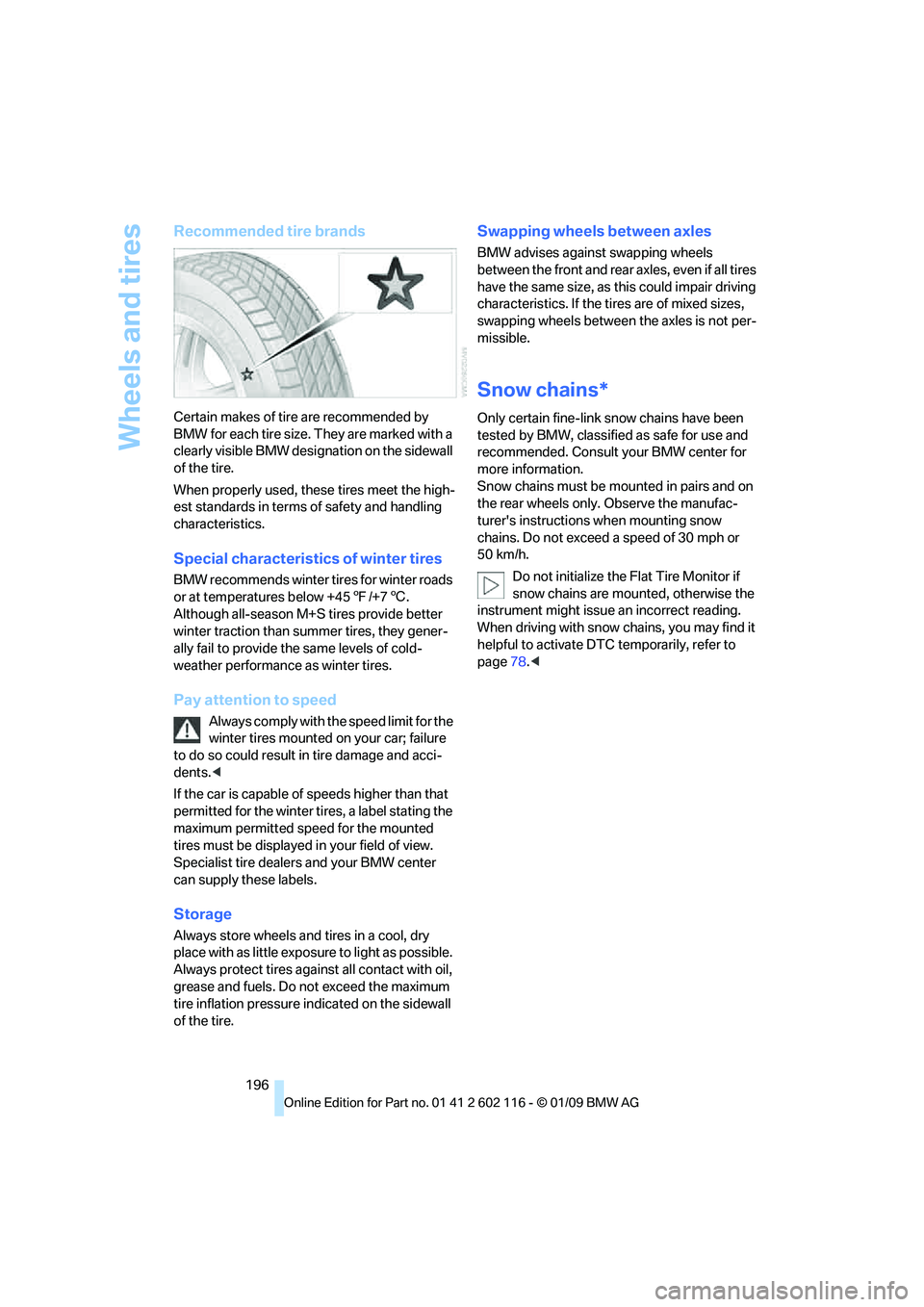
Wheels and tires
196
Recommended tire brands
Certain makes of tire are recommended by
BMW for each tire size. They are marked with a
clearly visible BMW designation on the sidewall
of the tire.
When properly used, these tires meet the high-
est standards in terms of safety and handling
characteristics.
Special characteristics of winter tires
BMW recommends winter tires for winter roads
or at temperatures below +45 7/+7 6.
Although all-season M+ S tires provide better
winter traction than summer tires, they gener-
ally fail to provide the same levels of cold-
weather performance as winter tires.
Pay attention to speed
Always comply with the speed limit for the
winter tires mounted on your car; failure
to do so could result in tire damage and acci-
dents. <
If the car is capable of speeds higher than that
permitted for the winter ti res, a label stating the
maximum permitted speed for the mounted
tires must be displayed in your field of view.
Specialist tire dealers and your BMW center
can supply these labels.
Storage
Always store wheels and tires in a cool, dry
place with as little exposure to light as possible.
Always protect tires agains t all contact with oil,
grease and fuels. Do not exceed the maximum
tire inflation pressure indicated on the sidewall
of the tire.
Swapping wheels between axles
BMW advises against swapping wheels
between the front and rear axles, even if all tires
have the same size, as th is could impair driving
characteristics. If the tires are of mixed sizes,
swapping wheels betwee n the axles is not per-
missible.
Snow chains*
Only certain fine-link sn ow chains have been
tested by BMW, classified as safe for use and
recommended. Consult your BMW center for
more information.
Snow chains must be mounted in pairs and on
the rear wheels only. Observe the manufac-
turer's instructions when mounting snow
chains. Do not exceed a speed of 30 mph or
50 km/h.
Do not initialize the Flat Tire Monitor if
snow chains are mounted, otherwise the
instrument might issue an incorrect reading.
When driving with snow chains, you may find it
helpful to activate DTC temporarily, refer to
page 78.<
Page 244 of 248
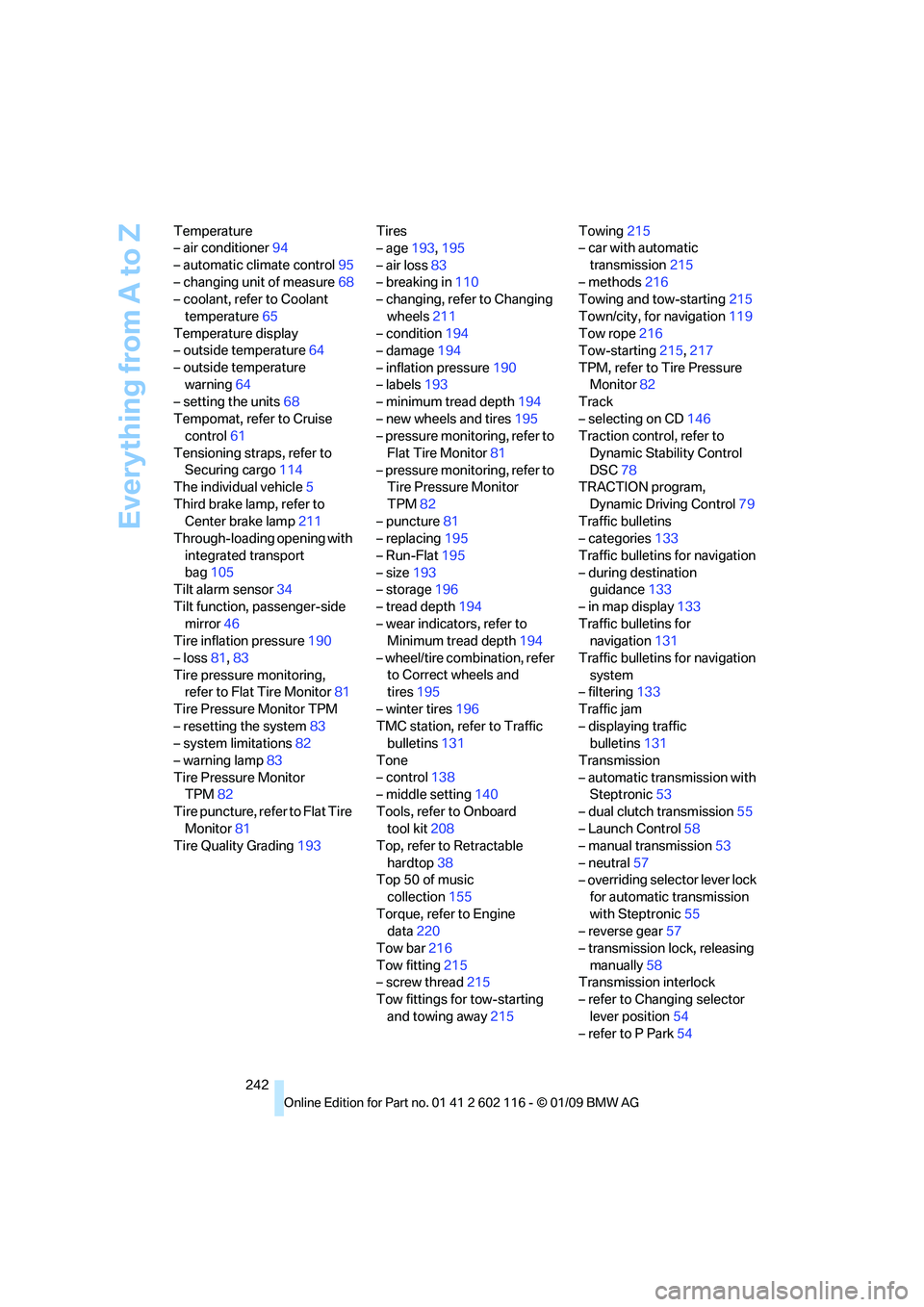
Everything from A to Z
242
Temperature
– air conditioner
94
– automatic climate control 95
– changing unit of measure 68
– coolant, refer to Coolant
temperature 65
Temperature display
– outside temperature 64
– outside temperature warning 64
– setting the units 68
Tempomat, refer to Cruise control 61
Tensioning straps, refer to Securing cargo 114
The individual vehicle 5
Third brake lamp, refer to Center brake lamp 211
Through-loading opening with
integrated transport
bag 105
Tilt alarm sensor 34
Tilt function, passenger-side mirror 46
Tire inflation pressure 190
– loss 81,83
Tire pressure monitoring, refer to Flat Tire Monitor 81
Tire Pressure Monitor TPM
– resetting the system 83
– system limitations 82
– warning lamp 83
Tire Pressure Monitor TPM 82
Tire puncture, refer to Flat Tire Monitor 81
Tire Quality Grading 193Tires
– age
193,195
– air loss 83
– breaking in 110
– changing, refer to Changing
wheels 211
– condition 194
– damage 194
– inflation pressure 190
– labels 193
– minimum tread depth 194
– new wheels and tires 195
– pressure monitoring, refer to
Flat Tire Monitor 81
– pressure monitoring, refer to Tire Pressure Monitor
TPM 82
– puncture 81
– replacing 195
– Run-Flat 195
– size 193
– storage 19
6
– tread depth 194
– wear indicators, refer to Minimum tread depth 194
– wheel/tire combination, refer to Correct wheels and
tires 195
– winter tires 196
TMC station, refer to Traffic bulletins 131
Tone
– control 138
– middle setting 140
Tools, refer to Onboard tool kit 208
Top, refer to Retractable
hardtop 38
Top 50 of music collection 155
Torque, refer to Engine data 220
Tow bar 216
Tow fitting 215
– screw thread 215
Tow fittings for tow-starting
and towing away 215Towing
215
– car with automatic
transmission 215
– methods 216
Towing and tow-starting 215
Town/city, for navigation 119
Tow rope 216
Tow-starting 215,217
TPM, refer to Tire Pressure Monitor 82
Track
– selecting on CD 146
Traction control, refer to
Dynamic Stability Control
DSC 78
TRACTION program,
Dynamic Driving Control 79
Traffic bulletins
– categories 133
Traffic bulletins for navigation
– during destination guidance 133
– in map display 133
Traffic bulletins for navigation 131
Traffic bulletins for navigation system
– filtering 133
Traffic jam
– displaying traffic bulletins 131
Transmission
– automatic transmission with Steptronic 53
– dual clutch transmission 55
– Launch Control 58
– manual transmission 53
– neutral 57
– ov
erriding selector lever lock
for automatic transmission
with Steptronic 55
– reverse gear 57
– transmission lock, releasing
manually 58
Transmission interlock
– refer to Changing selector
lever position 54
– refer to P Park 54